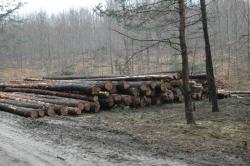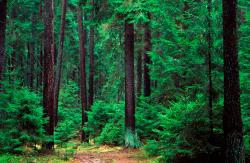 Asset Publisher
Asset Publisher
Polish forests
Poland is in the European lead, while concerning the area of all forests. They cover about 29,2 % of the country territory, and grow within the area of 9,1 million hectares. The overwhelming majority of the forests is state owned, of which almost 7,6 million hectares are managed by the State Forests National Forest Holding..
The number of Polish forest is still growing. The forestation rate of the country has increased from 21 % in 1945 to 29,2 % at the moment. Between 1995 and 2008, the forest area increased by 310 thousand ha. The basis for afforestation works is the "National Programme for Increasing the Forest Cover" (KPZL), assuming an increase of the forestation rate up to 30 % by 2020 and up to 33 % by 2050. Polish forests abound in flora, fauna and fungi. 65 % of the total number of animal species live there.
The forests grow in our country on poor soils, mainly because of the development of the agriculture in previous years. It influences the distribution of the types of the forest sites in Poland. Over 55 % of the forest areas is covered with coniferous forests. In other areas, there are forest sites, mainly the mixed ones. Their small part constitute alder and riparian forests – not more than 3 %.
In the years 1945 – 2011 the area of natural deciduous tree stands within the area of the State Forests National Forest Holding increased from 13 to 28,2 %.
Within the lowlands and uplands the most often occurring tee species is pine. It covers 64,3 % of the forest area of the State Forests National Forest Holding and 57,7 % of private and commune forests. In the mountains the predominant species is European spruce ( in the west) and European spruce with beech (in the east). Domination of pine is the result of carrying on sustainable forest management in the past. Once, the monocultures (crops or cultivations of one species) were the answer to the great demand of industry for wood. Such forests appeared to be quite fragile to climatic factors. They also were often the prey of pests' expansion.
In Polish forests, the share of other tree species, especially deciduous trees have been systematically increasing. The foresters have stepped aside from monocultures – that is why, they try to fit specific species of the forest stand to the natural stand, that would be proper for the given area. Thanks to that, in the years 1945 – 2011, the area of the deciduous tree stands within the lands of the State Forests National Forest Holding increased from 13 to 28,2 %. There occur more and more frequently the following tree species: oaks, ashes, maples, sycamore maples, elms, but also birches, beeches, alders, poplars, hornbeams, aspens, tilias and willows.
Our forests are the most often represented by the forest stands aged 40 to 80 years. The average age of the forest equals 60 years. More and more trees are of big size at the age over 80 years. Since the end of the Second World War, the forests' area has increased up to almost 1,85 million hectares.
Raport o stanie lasów w Polsce 2012
 Asset Publisher
Asset Publisher
 Asset Publisher
Asset Publisher
Zanim kupisz drewno
Zanim kupisz drewno
 Stos drewna S2a, Leśnictwo Bukowno. (fot. Dariusz Sroka)
Stos drewna S2a, Leśnictwo Bukowno. (fot. Dariusz Sroka)
 Sklejka bukowa. (fot. Dariusz Sroka)
Sklejka bukowa. (fot. Dariusz Sroka)
 Mygła dłużyc sosnowych, (fot. Dariusz Sroka)
Mygła dłużyc sosnowych, (fot. Dariusz Sroka)
Zakup drewna - co klient wiedzieć powinien
Sprzedaż detaliczna drewna mało, średnio i wielkowymiarowego odbywa się w leśnictwach.
Zakup detaliczny jest możliwy zarówno dla firm, osób prowadzących działalność gospodarczą jak i osób fizycznych. Bliższe informacje można uzyskać pod numerami telefonów poszczególnych leśniczych. Odbiór drewna z terenu danych leśnictw.
Sprzedaż dla firm odbywa się na podstawie umów rocznych będących wynikiem rokowań internetowych w Portalu Leśno - Drzewnym. Istnieje również dodatkowa możliwość zakupu drewna przez licytację w serwisie e-drewno.
Objaśnienie do cennika
oraz podstawowe zasady sprzedaży drewna w sprzedaży detalicznej
- Każde z leśnictw prowadzi sprzedaż detaliczną tylko w wyznaczonych dniach tygodnia tj. wtorek od 8.00 – 10.00 i we czwartek, od godz. 14.00 – 16.00.
- Ponadto w dowolnym dniu roboczym, po wcześniejszym uzgodnieniu z leśniczym.
- Adresy i telefony sprzedaży znajdziesz w zakładce „Kontakt"
- Aktualny cennik drewna zawsze znajdziesz w „Aktualnościach"
- Sprzedaż prowadzona jest w formie gotówkowej;
- Leśniczy po przyjęciu gotówki wydaje dokument uprawniający do wywozu drewna – asygnatę;
- Asygnata jest ważna tylko wraz dowodem zakupu drewna (paragon fiskalny bądź faktura);
- Dowodem sprzedaży jest wręczany nabywcy drewna oryginał paragonu fiskalnego lub na wyraźne życzenie kupującego – faktura;
- Oryginał faktury wysyłany jest na adres Klienta (istnieje możliwość osobistego odbioru faktury w biurze Nadleśnictwa, nie mniej - ze względów technicznych - osobisty odbiór faktury jest możliwy w następnym dniu roboczym po zakupie drewna);
- Faktury wystawiane są wyłącznie w biurze Nadleśnictwa w dniu wystawienia asygnaty (nie później niż w ciągu 3 miesięcy licząc od końca miesiąca, w którym drewno zostało zakupione), po przesłaniu drogą teleinformatyczną z kancelarii leśnictwa do biura Nadleśnictwa.
- Nabywca ustala z leśniczym termin wywozu drewna w przedziale czasowym określonym na asygnacie (7 dni od daty zakupu); - Warunki sprzedaży drewna
- Zakupionego drewna nie wolno nabywcy zabierać bez uprzedniego okazania asygnaty pracownikowi administracji leśnej (leśniczemu lub podleśniczemu) i bez uzyskania adnotacji o wydatku drewna (data wywozu);
- W razie niemożności wywozu w wyznaczonym terminie, nabywca winien uzgodnić telefonicznie nowy termin wywozu.
 = 1 mp (metr przestrzenny)
= 1 mp (metr przestrzenny)
Ułożone w stos drewno zawiera puste przestrzenie (w tym korę).
Zazwyczaj 1 mp to ok. 0,65 m3, dla graba, buka i świerka to ok. 0,70 m3
Sprzedaż choinek
Sprzedaż choinek odbywa się w okresie przedświątecznym leśniczówkach.
Mapy i adresy znajdą Państwo w zakładce kontakt.
Nadleśnictwo Chrzanów informuje że nie prowadzi sprzedaży sadzonek drzew i krzewów.


 fot. Paweł Fabijański
fot. Paweł Fabijański
 fot. Paweł Fabijański
fot. Paweł Fabijański
 fot. Paweł Fabijański
fot. Paweł Fabijański




